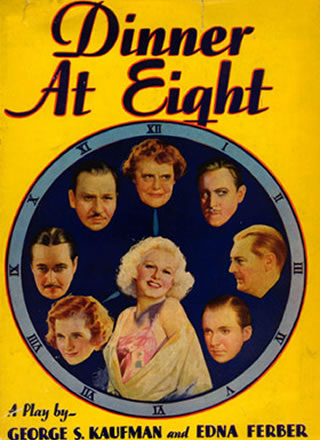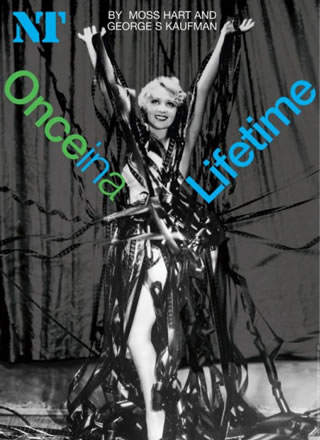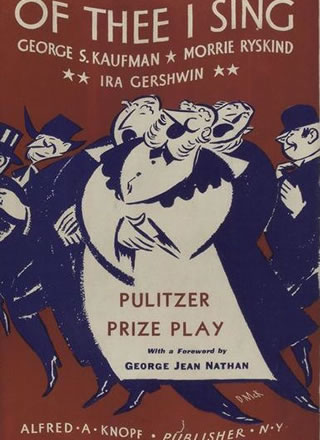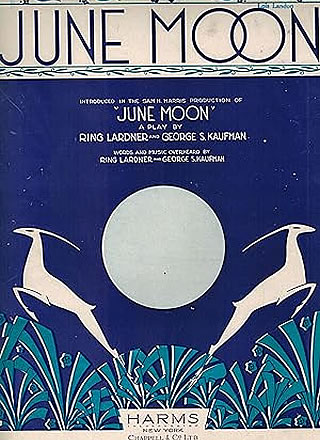Dinner At Eight
(1932)
By George S. Kaufman and Edna Ferber

Cast size: 15 men, 12 women, 7 interiors
For their second collaboration, Ferber and Kaufman created a complex portrait of New York at the height of the Depression—so complex, in fact, that Kaufman refused to attempt the project for many years.
For performance rights, contact: Concord Theatricals

Table of Contents
The Plot
 “From the society column of the New York Times: Mr. and Mrs. Oliver Jordan of 927 Park Avenue, entertained at dinner last night in honor of Lord and Lady Ferncliffe. Their guests included Miss Carlotta Vance, Mr. and Mrs. Daniel Packard, Dr. and Mrs. J. Wayne Talbot, and Mr. Larry Renault. Following the dinner Mr. and Mrs. Jordan and their guest attended a musical comedy…”
“From the society column of the New York Times: Mr. and Mrs. Oliver Jordan of 927 Park Avenue, entertained at dinner last night in honor of Lord and Lady Ferncliffe. Their guests included Miss Carlotta Vance, Mr. and Mrs. Daniel Packard, Dr. and Mrs. J. Wayne Talbot, and Mr. Larry Renault. Following the dinner Mr. and Mrs. Jordan and their guest attended a musical comedy…”
The dinner party hosted by the Jordans turns out to be the most disastrous theatrical banquet since the Scottish play. Despite her attempts throw the perfect dinner, Mille Jordan is confounded by events beyond her considerable control: Dan Packard, a business tycoon has just gobbled up her husband’s shipping line; Packard’s wife, Kitty, is having an affair with Dr. Talbot; Millie’s daughter is having an affair with the aging matinee idol Larry Renault, who is suicidal over his career prospects; and the glamorous Carlotta Vance, a former paramour of Oliver’s is about to sell all her stock in his company to Dan Packard.
By the time the butler announces that “dinner is served,” a microcosm of Depression society has been thrown together and shaken by the thousand little dirty secrets that connect each person to another, no matter what their class.
About the Play
 For their second collaboration, Cast size: 15 men, 12 women, 7 interiors created a complex portrait of New York at the height of the Depression—so complex, in fact, that Kaufman refused to attempt the project for many years. Ferber was always fascinated by multi-generational, interrelated stories; decades before the advent of soap operas and television shows like Dallas, she practically invented the interwoven narratives of the rich and powerful. Kaufman’s gift for construction effortlessly keeps a dozen separate stories in the air, while each scene tightens the skein that keeps all the characters together.
For their second collaboration, Cast size: 15 men, 12 women, 7 interiors created a complex portrait of New York at the height of the Depression—so complex, in fact, that Kaufman refused to attempt the project for many years. Ferber was always fascinated by multi-generational, interrelated stories; decades before the advent of soap operas and television shows like Dallas, she practically invented the interwoven narratives of the rich and powerful. Kaufman’s gift for construction effortlessly keeps a dozen separate stories in the air, while each scene tightens the skein that keeps all the characters together.
Although a stage version of Vicki Baum’s Grand Hotel has opened more than a year before, Kaufman and Ferber banked on the basic contemporaneity of their subject and the kaleidoscopic view of New York society resonated with critics and audiences. American drama has very few real comedies of manners—unlike British theatre, which has many—and Dinner at Eight is one of the finest examples of this genre.
The MGM film version from 1933, directed by George Cukor and starring, among others, Marie Dressler, Jean Harlow, and John and Lionel Barrymore, was itself a successful follow-up to the film of Grand Hotel, which also featured the Barrymores. It cemented MGM’s reputation as the all-star studio and provided audiences with one of the 1930s most successful films. The following bit of dialogue—written by Herman Mankiewicz—has become legendary; alas, it’s not in the play:
Kitty: I was reading a book the other day.
Carlotta: Reading a book?
Kitty: Yes. It’s all about civilization or something. A nutty kind of a book. Do you know that the guy says that machinery is going to take the place of every profession?
Carlotta: Oh, my dear, that’s something you need never worry about.
Stage history
Due to its elaborate production of seven sets, the show did not tour prior to its Broadway opening, premiering instead on October 22, 1932 at the Music Box Theatre. It received rave reviews and ran 232 performances. The starry film version largely eclipsed its stage history, until Sir Tyrone Guthrie directed a revival on Broadway in 1967. The Long Wharf Theatre in New Haven gave the play a scaled-down production, featuring Elizabeth Wilson and Charles Keating, in 1989. Lincoln Center Theater produced a glittery revival in 2002, with Christine Ebersole and Marian Seldes as Carlotta Vance; it was nominated for several Tony Awards, winning Best Set Design for John Lee Beatty’s elegant settings.
Other Plays in the Catalogue
Another dynastic epic from the typewriters of Kaufman and Ferber, but this time with a serious tone and a pointed intention. The Kincaid family has made its money from some pretty rough-and-ready tactics during the Western expansion of the railroads in the 19th Century.
In the heady days of the New Deal, the government was dispensing a check to thousands of worthy organizations around the country. Two unscrupulous bankers decide to bilk Washington, DC by starting a phony railroad, farm, and bank securities system—all based out of their New York apartment.
By Ring Lardner and George S. Kaufman. Cast size: 7 men, 5 women (One man can be cut); 3 sets. June Moon was the last major comedy to open on Broadway before the Stock Market Crash. It had its premiere on October 9, 1929 at the Broadhurst and ran 249 performances.
Table of Contents
Contact Us Today
Interested in bringing George S. Kaufman’s timeless plays to your stage?
Please refer to the contact information for each specific play on the various collection pages for direct amateur and professional licensing information.
Plays are represented by Concord Theatricals, Broadway Dramatic Licensing, and Music Theatre International respectively
If you are interested in first-class performance or film/television rights:
In the US, George S. Kaufman’s plays are represented by:
CPK Artists, LLC
In the UK, George S. Kaufman’s plays are represented by:
Alan Brodie Representation
For more information about George S. Kaufman or this website, contact:
Laurence Maslon
Literary Trustee, George S. Kaufman Estate







